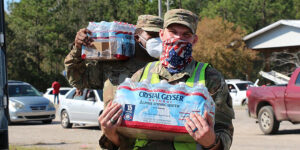

Sacramento P.D. Incorporates Training with Private-Sector Businesses
Domestic Preparedness
October 26, 2011
“Treat your employees right and they will treat the customers right.” That is both the motto and the official policy of the Sacramento, California, Police Department (P.D.). And, thanks to some helpful advice from Target and other area businesses, the results show it – a surprising drop in the local crime rate, for example, despite recent budget cutbacks.

MCM Dispensing: The Public Health Point of View
Raphael M. Barishansky and Audrey Mazurek
October 26, 2011
To plan for and defeat the frequently changing threats posed by pandemics (both natural and terrorist-related) requires advance planning, comprehensive training, and stockpiling mountains of supplies, including medications needed to protect literally millions of citizens. But these efforts involve numerous complexities.

HICS National Summit: Building on the Past, Preparing for the Future
Craig DeAtley
October 26, 2011
A distinguished DomPrep40 Advisor presents his exclusive insider’s report on a “Summit Meeting” held in California earlier this month during which the nation’s current Hospital Incident Command System (HICS) guidelines were discussed, debated, and dissected in minute detail. New policies that will develop as a result may well affect the health and well-being of all Americans for many years to come.

Tennessee Hospitals Use HERT to Enhance Preparedness
Shannon Arledge
October 19, 2011
The versatile Center for Domestic Preparedness, already a true national asset, continues to expand its curriculum – and its value to healthcare professionals throughout the country. The center’s Hospital Emergency Response Training course, the latest example, provides “incredible” hands-on training that will be particularly valuable in dealing with the decontamination phases of mass-casualty incidents.

Public Health Lessons from Hurricane Irene & Tropical Storm Lee
Beth McAteer
October 19, 2011
Lee caused less damage and fewer fatalities, but vigorously reinforced the lethal lessons learned from Irene less than two months ago – namely, that: (a) There is absolutely no substitute for advance planning; (b) Planning must be as totally comprehensive, in every way, as is humanly possible; and (c) That saving of human lives must be at the very top of the priority list.

The Public Health Ethics of Contagion
Bruce Clements
October 12, 2011
The recent film Contagion illustrates the challenges a society may experience when facing a rapidly spreading and highly lethal virus. Director Steven Soderbergh carefully constructed the film to reflect a realistic public health and medical response to a severe pandemic. Many of the technical public health aspects of the film are believably depicted; the disease transmission pathways demonstrated in the film are plausible, for example, and the core issues discussed by public health officials also are both credible and accurate. Included in the latter are relevant comments about the epidemiological investigation and such basic infection control measures as social distancing and the frequent washing of hands.

Radiological and Psychological Medical Countermeasures
Sophia Paros
October 12, 2011
As natural and manmade disasters increase in intensity, the need for hospital preparedness plans, as well as mass relocation plans, becomes critical when taking into account the public health and medical needs of at-risk individuals and groups in the event of a public health emergency.

FINAL REPORT: Resilience – 2001 to 2011, and Beyond
Kay C. Goss, Albert V. Romano, Glen Rudner and Douglas Kinney
October 12, 2011
Experts agree that an “All of Nation” approach is the key component for effective resiliency
planning. Resiliency starts from the bottom, where the needs are recognized and defined, and supported
all the way to the top, where partnerships and collaboration make it all possible. This report provides
valuable information for responders, receivers, planners, and managers in the public and private sectors
who strive to build more resilient communities across the nation.

Afterglow – Countering the Deadly Effects of Radiation
Joseph Cahill
October 5, 2011
Silent, odor-free, invisible, and deadly: The radiation left by a dirty bomb, hazmat spill, or
laboratory accident is usually difficult to detect and represents a “double danger” not only to those
already on the scene of a potential mass-casualty incident but also to the EMTs and first responders
seeking to save others – often at the risk of their own lives.

CDP’s School Bus Enhances Mass Triage Scenario
Shannon Arledge
October 5, 2011
The “first child” could not be saved, which meant that considerable time had already been wasted. But real life is a grim teacher – which is exactly why the Center for Domestic Preparedness makes its chilling incident scenarios as lifelike and realistic as possible. The end result: Invaluable training for thousands of responders from all areas of the country – at no cost to their own communities.

